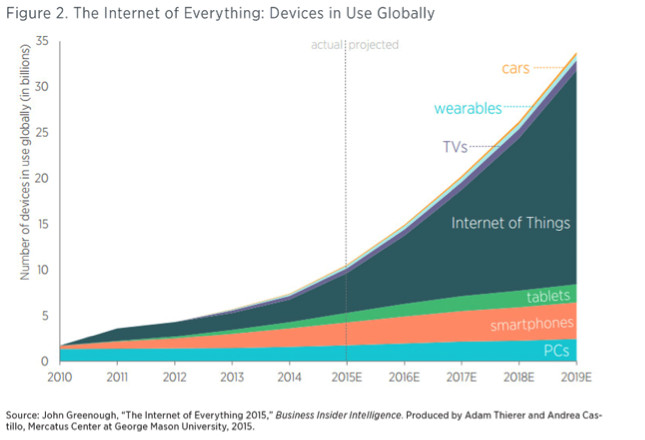The industrial internet for business leaders: Making it simple
October 20, 2016

Connected things are becoming pervasive among consumers and business alike. It's hard to open a newspaper or trade magazine or watch a news channel an...
Connected things are becoming pervasive among consumers and business alike. It’s hard to open a newspaper or trade magazine or watch a news channel and not see a story that is in some way related to the IoT. While giant companies like Apple, Google, and Amazon get the headlines with their cool new consumer devices, a “long tail” of commercial and industrial connected products is being rolled out today by manufacturers of all sizes. I’ve observed first hand successful new product introductions across a wide range of vertical industries and applications. These new offerings are beginning to transform sleepy and mundane industries far and wide.
Many of these concepts aren’t necessarily brand new, and some were known by different labels in the past – SCADA systems, telematics, machine-to-machine (M2M) communications. Europe has coined another related term: Industry 4.0 – literally a fourth industrial revolution.
Real world examples
The IoT isn’t just buzzwords and abstract future concepts and promises, however. There are many concrete examples of the IoT in action today. Here are just a few areas of innovation:
- Industrial equipment is being remotely monitored across far-flung distances and often in harsh environments in areas such as oil and gas and mining.
- In agriculture, moisture sensors are being used to minimize water usage while maximizing crop yields.
- Public street lighting is being updated with LED and wireless mesh network technologies to reduce operating costs and improve public safety.
- Drones are being used across a number of industries, including agriculture, real estate, and security.
- Commercial buildings are being retrofitted with next generation, connected HVAC systems that can factor in weather and other outside elements to maintain comfort and save energy.
- Smart parking systems are being implemented that can guide you to scarce open parking spots and enable dynamic pricing.
There are countless more examples of new connected commercial and industrial products being developed using IoT technologies. For those manufacturers with the vision, these are exciting times.
What are the business drivers for IoT?
Along with vision, IoT projects need funding justification with a business case. I’ve observed that there are principally four main business drivers for commercial IoT projects.
- Comply with new regulations. An example is the FDA’s Food Safety Modernization Act. Another example is the DOT’s new rules for commercial drivers around e-logs and hours of service.
- Reduce or avoid costs. Examples include field service, logistics, and supply chain optimization. In plain terms, businesses are eliminating the costs of unnecessary truck rolls and only ordering more supplies exactly when needed. Don’t fill things until they’re empty; don’t empty things before they’re full. Move from scheduled maintenance to a predictive maintenance model. Also, companies are using IoT to prevent inventory losses among valuable, perishable assets like food and pharmaceuticals.
- Differentiate your product. Industrial products companies are offering connected product features as adjunct offerings to differentiate themselves from competitors, increase revenue, avoid commoditization, and enable better reliability and uptime. Additionally, manufacturers are using connected product customer usage data to gain insights and improve roadmaps.
- Generate new revenue streams. Monitoring a product you’ve sold your customer can enable premium service levels, as well as entirely new managed services revenue streams for manufacturers. IoT is also reinventing the concept of equipment leasing: IoT enables managed hardware-as-service monitoring offerings that bundle device with connectivity and the application. This is opening up recurring revenue-based business models for traditional manufacturers.
Think big or small?
A straightforward and practical approach should be used when embarking on an IoT project. This should not be viewed as a massive, company-changing effort, but rather a series of small projects or digital test beds that have the potential to increase revenue, improve the bottom line or boost customer retention. While we all recognize the opportunity for success, realize that not all IoT initiatives will succeed, some say that about half will fail. If you have that in mind (failure on some trials or projects will happen) then company expectations about success are reasonable.
A reasonable approach is to pick a few products and services to which adding sensors and connecting them could possibly result in substantial improvement to the organization’s bottom line. In addition, identify three more products and services that could possibly lead to additional sources of revenue. Research has shown from a portfolio of six projects, one will be a big success, two will be average hits and three will fail.
This approach is manageable and if the pilots are successful, they can be part of the company’s offerings. If they don’t succeed, they can be considered useful learning experiments; continue and iterate on the others. This process should be repeated. When implementing, one should consider the organizational culture, ensure buy-in from the top management team, identify digital directors, transform your company culture, etc. Even with all necessary systems and processes in place, a strategy can be crushed by old visions of what the company is or aspires to be.
Summary
The industrial IoT is real. It’s here today and it’s available to anyone. It offers manufacturers large and small ways to reimagine their business and tap market opportunities.
IoT-related technology costs have fallen steadily, enabling access for smaller industrial companies that passed on earlier M2M or telematics technologies. An exciting list of new and innovative connected products are being introduced across a wide range of industries today, and not just by blue chip titans. Business cases and business models are emerging right now. However, understanding the pieces of IoT technology is critical to minimize risk and costs, and ensure success in any connected product development strategy.
In our next article we will answer the question, “Where do I start?” for business leaders seeking to create their company’s industrial IoT strategy.






